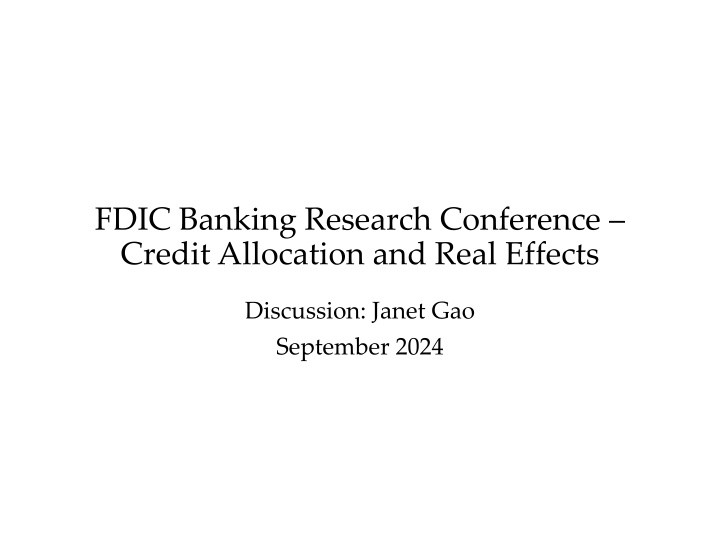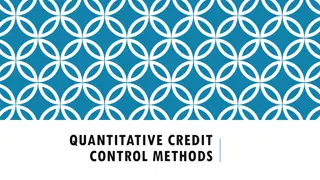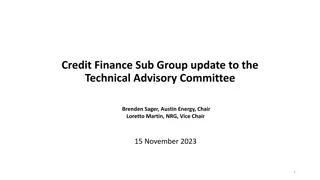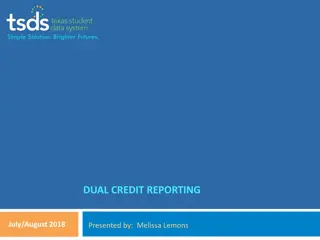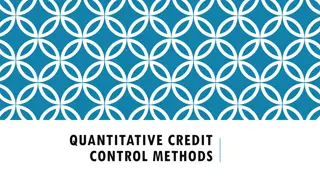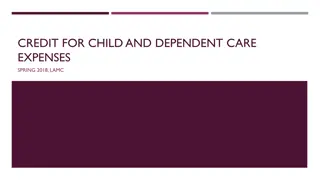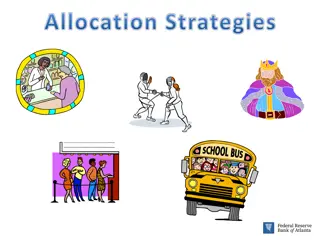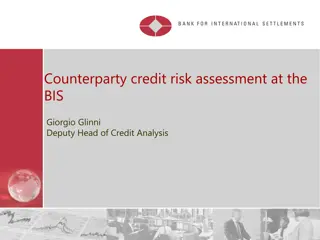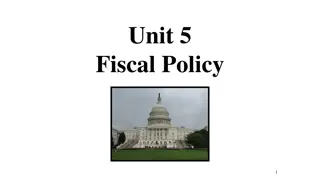Credit Allocation and Real Effects: Government Policy Impacts
Studies on policy impacts by U.S. government agents on credit supply show reduced lending with tighter regulations. Explore findings on housing speculation, GSEs, and credit market spillovers, highlighting challenges in policy design for financial inclusion.
Download Presentation

Please find below an Image/Link to download the presentation.
The content on the website is provided AS IS for your information and personal use only. It may not be sold, licensed, or shared on other websites without obtaining consent from the author.If you encounter any issues during the download, it is possible that the publisher has removed the file from their server.
You are allowed to download the files provided on this website for personal or commercial use, subject to the condition that they are used lawfully. All files are the property of their respective owners.
The content on the website is provided AS IS for your information and personal use only. It may not be sold, licensed, or shared on other websites without obtaining consent from the author.
E N D
Presentation Transcript
FDIC Banking Research Conference Credit Allocation and Real Effects Discussion: Janet Gao September 2024
Overview Housing Speculation, GSEs, and Credit Market Spillovers Government Litigation Risk and the Decline in Low-Income Mortgage Lending Two very interesting papers! Both papers study important policy questions and are very well executed. Both studies demonstrate incredible data efforts and produce very interesting results. Both examine the effects of policy implemented by U.S. government agents on the credit supply of mortgage lenders. Government Policies/Regu lations Lenders (intermediaries) Households & Businesses
Overview Collectively, these studies suggest that policies have important impacts on credit markets and generate real effects Policies are effective (to a certain extent): Tighter/More restrictive regulations lead to reduced lending by the regulated entities Imperfect substitution of credit supply from other, unaffected lenders Households and small businesses face reduced credit Highlight the difficulty of designing policies that protect government agencies from risk exposures and maintain financial inclusion/access Government Policies/Regu lations Lenders Households & Businesses (banks/nonbanks)
Housing Speculation: Outline of Findings Policy: Reduction in the GSE purchasing cap of speculative & risky mortgages Background: During the 2008 financial crisis, Fannie Mae and Freddie Mac were taken into government control. In 2021, the U.S. treasury and FHFA announced purchase caps for those agencies: %risky home purchase single-family mortgage <6% %risky refinance mortgage <3% %speculative mortgages <7% These purchase caps, if binding, would create obstacles for lenders to finance risky mortgages (i.e., a negative financing shock to the lenders) Lots of results! The policy drastically reduced the origination and sale of speculative mortgages, but not risky ones. The policy also increased the origination of safe mortgages
Housing Speculation: Outline of Findings Interestingly, lenders still choose to sell riskier loans within the limit of the policy Interest rates increase by 10 basis points Some real effects Less speculative housing transactions Reduced transaction volume and prices However, no evidence the reduction in credit supply lead to changes in wages and employment
Housing Speculation: Empirical Comments With lender-quarter FE, the baseline specification is a within-lender comparison across Speculative, Risky, and Safe mortgages. Safe mortgages are the benchmark group What is the correct counterfactual? Speculative housing investment (second homes or investment homes) during pandemic So the authors use the origination/sale of safe mortgages to proximate the counterfactual, i.e., origination/sale of speculative mortgages absent the policy Reasons why speculative housing investment may decline more than regular house purchases: As the pandemic disrupts labor and product markets, households refrain from making frivolous purchases (demand-side effect) With the disruption in global supply chains comes frequent delays in construction, and surging construction cost. Both households and lenders may be more concerned of the risk of housing investment
Housing Speculation: Empirical Comments During the sample period, many macro conditions shifted, which could affect housing investment With sharp changes in macroeconomic conditions affecting income and construction costs, second homes and investment homes are the most elastic margins of adjustment, this could explain why speculative mortgages respond more than risky ones
Housing Speculation: Literature Many studies have shown that financing/liquidity shocks to banks, esp. those induced by government policies, affect credit supply In particular, Loutskina and Strahan (2009, Securitization and the Declining Impact of Bank Finance on Loan Supply: Evidence from Mortgage Originations)look at bank liquidity shock, induced by Fannie Mae and Freddie Mac s inability to purchase jumbo mortgages. Then examine its differential effects on the origination of jumbo mortgages relative to non-jumbo ones Loutskina (2011) finds that banks ability to securitize loans facilitates lending The authors explain that they provide the most direct evidence that GSE subsidies affect mortgage credit supply What is special about this regulation? Or in other words, why would we not expect the policy to affect lending? What can we learn about the inner works of banks, or financial markets, from this policy shock? Is it about the uniqueness or irreplaceability of GSEs?
Housing Speculation: Policy Implications Overall, how do we evaluate the policy? Clear evidence that the policy affected how banks financed conforming mortgages The policy affected housing market transactions and loans to small businesses Very interesting to see that the policy spilled over to the small business lending sector Does the cost of financing increase for banks? But cost of financing is contingent on the type of loans they make No detectable effects on employment and wages: The effects of the policy may have been overwhelmed by the concurrent macro shocks, such as the government subsidies (e.g., tax relief act, American Rescue Plan, PPP in late 2020, etc.) Also possible because this is a market indirectly affected by the policy
Government Litigation Risk: Background Compliance costs have increased substantially over the past few years Even breeds an industry developing technologies for bank compliance
Government Litigation Risk: Overview This study examines a specific aspect of compliance, eligibility to FHA insurance in a high-risk mortgage market Policy shock: The Department of Justice and HUD launched a series of lawsuits against 31 large lenders for fraud among FHA-insured mortgages, with fines totaling $5 billion How do government lawsuits, as well as the threat of lawsuits affect credit provision to low-income households? Main takeaways: Targeted banks exited the FHA market, leading to a sizable reduction in loan provision, with no change in average default risk Smaller banks do not seem to fill in the void Ultimately, this leads to a reduced access to financing and home ownership for low-income households Policy questions: Are the lawsuits too heavy-handed ? Do the regulators to punish FHA fraud too much?
Government Litigation Risk: Credit Quantities Define all large (top 5%) lenders as treated , not just the litigated ones, because even the untargeted lenders may fear lawsuit. The results essentially reveal the deviation of large lenders vs. small lenders in their participation in the FHA markets. But mechanisms are unclear Are the results coming from litigated lenders or non-litigated ones? The former indicates the effect of fines + enhanced regulatory scrutiny The latter indicates the anticipation of lawsuits Are there reasons to believe that only large lenders feared government litigations? Small and mid-sized banks face greater compliance burden (relative to their income).
Government Litigation Risk: Credit Standards The study finds no effect of the lawsuits on borrower characteristics (FICO, DTI), and no effect on delinquency. Interpretation: there is no change in credit standards. While statistical significance is low, the coefficients are all negative and the magnitudes may be meaningful (Should discuss in the paper) Is it possible that the loan quality did improve, but the test does not have sufficient power to capture it?
Government Litigation Risk: Credit Standards Is it also possible there is an adverse-selection effect? Borrowers may be adverse to litigation outcomes, so they do not apply for FHA mortgages. The only ones remaining are the lower- quality borrowers. So even if top lenders have tightened their lending standards along some observables (such as DTI and FICO), we do not observe an increase in loan quality (Imperfect) Suggestions for the delinquency analysis: Given that the sample is at the loan level, you can directly compare the outcome of loans originated by treated vs. control banks, instead of highly vs. lowly exposed counties (may need to match HMDA data with loan performance data) This also allows you to better control for observables and compare changes in delinquency within observables
Government Litigation Risk: Supply vs. Demand The DOJ lawsuits likely discouraged FHA demand and supply. In an average market, FHA loan quantity reduced but interest rate did not change. It is possible that both the supply curve and the demand curve shifted to the left, leading to little changes in prices (even in low-competition areas, there s only small increase in interest --- again, should discuss magnitudes) Is there a way to separate the two and gauge how much each side contributes to the policy effect? R S D Q
Government Litigation Risk: Identification In the lender-level analysis, the main specification uses lender and county-year FE. It compares the origination of FHA loans from top 5% lenders vs. non-5% lenders. What is the correct counterfactual? Should we be comparing Citigroup and JP Morgan Chase to local banks and credit unions? You can narrow the comparison by looking at top 5% lenders to the top 5-10% lenders. While the latter is also affected by lawsuit risk to a certain degree, the intensity of treatment should be lower, and they are arguably more similar to the top 5% lenders Use a matched sample based on lender characteristics Can also look at within-lender differences, by imposing lender-year fixed effects ( portfolio tilt ) Again, it would be helpful to use more granular data for the delinquency analysis
Government Litigation Risk: Policy Implications What do we learn about policy-making in this study? The study shows that The policy squashed the FHA origination by large lenders, via several potential channels: the cost of fines, the threat of litigations, and the anticipation of higher underwriting costs FHA lenders do not tighten lending standards after the shock Low-income households receive less credit The lack of changes in credit standards is the key, which would suggest Large lenders did not originate loans that were too risky prior to the lawsuits The lawsuits ended up punishing low-income households, whom the FHA was meant to support However, lending standards may have tightened in other dimensions (other than FICO and DTI), and delinquency risk could also change if the counterfactual changes
Conclusion Papers in this session study the effects of policies and regulations in the mortgage market. Housing Speculation examines a policy that creates obstacles for lenders to securitize (finance) speculative loans Government Litigation Risk examines the effect of lawsuit concerns regarding FHA insurance eligibility Both policies achieved the intended effects, but also had unintended consequences. Lenders seem to over-react to policies and cut lending too much. The policy can have spillover effects across regions and markets. In recent work (Algorithmic Underwriting in High Risk Mortgage Markets), my coauthors and I discovered that an FHA policy that relaxed lending standards not only led to a substantial credit expansion to low-income households, but also enabled households to move to better neighborhoods (i.e., better schools) The effect, however, is muted for Black borrowers and lower-income borrowers among the affected group. Altogether, research highlights the tricky balance between financial inclusion and risk-avoidance.
Conclusion For the research on bank policy shocks and real effects We have learned in many contexts that shocks to banks, either through financing channels or regulatory restrictions, affect lending, which in turn generates real effects What are the main points of innovation/contribution? Effects of the study unveil frictions (market or institutional) Whether the policy is effective depends on the importance of the mechanism that is altered by the policy Whether the credit market is sufficiently competitive The elasticities of supply/demand in the credit market as well as the labor market Government Policies/Regu lations Lenders (intermediaries) Households & Businesses
